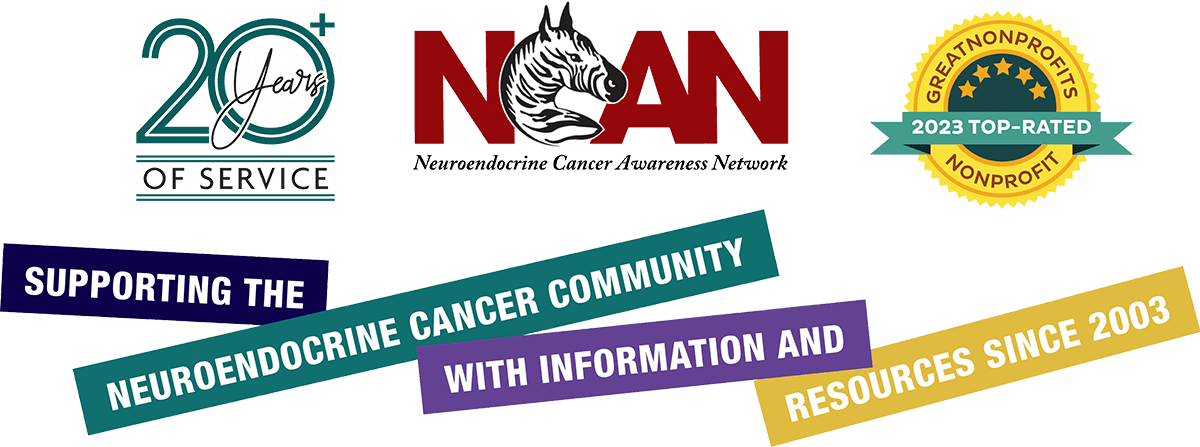February 1, 2023
By Anne Dabbs,
NCAN TN Chapter Leader, NET Patient

If you spend anytime at all discussing our Neuroendocrine Cancer with other NETs patients, you quickly learn that there is a whole new vocabulary to master as you learn about our disease. Identifying labels such as our primary tumor locations are valuable tools as we discuss our challenges. Our Tumor Grade values also provide necessary context for meaningful and beneficial conversations. These values are especially important to insure that we are not making incorrect assumptions based solely on our own experiences.
Our labels in patient conversations can differ from those terms and phrases used by our medical providers. It is always best to clarify your understanding of new words and abbreviations with your physicians. There are some labels within our Neuroendocrine World that can be interpreted incorrectly without a basic knowledge of Neuroendocrine Tumor behavior. Those misunderstandings can then become be misleading.
Let’s take a look at INDOLENT, N.E.D. and CURED.

INDOLENT is frequently used by our physicians to describe our Grades 1 and 2 Net Cancers. Indolent rarely refers to Grade 3 unless the tumors are well-differentiated and responding well to treatments.
Merriam-Webster-Webster Dictionary tells us that indolent can mean: averse to activity, causing little or no pain, and/or slow to develop. Those of us who have been told we have a slow growing cancer need to be reminded of this definition. Being indolent is a hallmark for a patient who is in a watch and wait mode of surveillance .

N.E.D. = No Evidence of Disease.
Once a Neuroendocrine patient connects with other previously diagnosed NETs patients, they quickly learn that NED is our buzz word. NED IS GOOD in this world of an incurable disease! Everybody wants to be NED! However, with time, Neuroendocrine patients learn that the correct interpretation of NED is: “no cancer is currently detectable in the body’. MDAnderson’s website is quick to remind us that “currently detectable” is the key phrase. Don’t get me wrong, NED is still great and wonderful and worth celebrating, but don’t become overconfident or complacent in your surveillance of your disease. It can be a precarious state. Cancer cells might still be lurking at a level that, at present, can’t be detected.

CURED is a phrase less often used by our Neuroendocrine Specialists and highly NETs knowledgeable physicians. Cleveland Clinic tells us that cured means “completely gone and is not coming back”. Merriam-Webster Dictionary defines it as a “complete restoration of health”. Our Neuroendocrine Specialists know that there are a small handful of situations where a surgical intervention might be considered curative, but that for the majority of us, cured is simply not yet in our disease vocabulary.
So what do we, as NETs patients, do with these labels? We use them to our advantage.
When your physician tells you your disease is slow growing and indolent, you take a deep breath, give thanks, and stay current in your treatments and education about your cancer. You work to incorporate this diagnosis into your life without a dark cloud hanging over you.
When you hear that you have been deemed NED following a treatment or a scan, you enjoy a quick celebration and promise yourself, your family, and your friends that you will not become lazy or forgetful about your surveillance. And, you accept that NED might not be forever. NED truly means right now by the best means available to assess your status. Next month, it could be different.
And, when you hear that you are cured of your Neuroendocrine Disease by someone other than a NETs specialist who is familiar with your case, you say “thank you, but no thank you. I need a second opinion”. And, you do just that. You read more, learn more, and make connections with those physicians who truly understand Neuroendocrine Cancer and its unique behavior. Only then, would the word “cured” have merit.
When I try to label my personal case of Neuroendocrine Cancer, I know that I have accepted that NED and Cured will never be a part of my prognosis. Indolent, however, I am happy to embrace. Being indolent also means that most likely my disease is evolving. That might be progression, or it might not. But I know for sure that it is not stagnant.
We, here at NCAN, recognize that a healthy mindset with this disease requires an understanding of the most basic labels and classifications. Knowledge is power when dealing with an incurable (at present) disease. We encourage you to visit the Resource Room and Glossary on the NCAN website and to take advantage of the Podcasts and Videos available on the NCAN YouTube channel to stay educated and informed. Also, make time to join us at an upcoming Patient Conference where you can build your NETs knowledge surrounded by the support of the NET Community.
Find out more about how YOU can help the NET Community.
Disclaimer: NCAN blog posts are the opinions of its writers and are not intended as a replacement for medical advice. Please consult your Health Care Providers for individual concerns.


Comments(4)-

-

-

-

Donna says
March 10, 2024 at 5:43 pmI will turn 70 in April. I was diagnosed officially in June 2016 so have been living with NETs for almost 8 years. Initially I had extensive surgery. Primary was in terminal ilium but it had metastasized to my liver and mesentery. I had tumors everywhere. I also had a great surgical oncologist who got everything out. Resected liver, ablations and removal of terminal ilium, part of colon and appendix. I was started on somastatin 30 once I saw a specialist at Vanderbilt. In 2023 after my scan my doctor called and said he was concerned about my lungs. He wanted me to have a bronchoscopy. The results were that I had a very bad infection called MAC, difficult to treat requiring about 15 Months of 3 strong antibiotics. In July I experienced excruciating pain in my lower back and there as concern I might have bone spread. The Dr ordered my 1st rotate scan. There was no bone involvement but there was uptake in my lungs and 13 tumors in my liver. I had had a sputum test in September to see if the MAC was still showing. It was not but they found a second infection Nocardia nova. Can be deadly. I changed pulmonologist and because of the rotate scan he wanted to do a biopsy but prior another chest scan. The results showed almost complete resolution of the mass in my lung and a follow up sputum did not show the Nocardia. A miracal. My two oncologists covered after the rotate scan and decided I would probably need PRRT in the spring. My scan in November compared to the dotate showed no growth. So my oncologist here said we might wait a bit for PRRT. In February my specialist did a scan and said there was no growth. But now he is going to do a dotate in May. He also has changed his mind and said that he no longer believes doing PRRT earlier than later is better than waiting. I’m so confused. I know I have numerous problems besides the cancer (my white and red counts can be quite low). He told me he’s never had a NET patient that had so much going on physically and I would be the one to get leukemia or mylosuppression from PRRT. That’s where things stand. Any thoughts
Diana Kisiday says
June 1, 2023 at 4:07 pmI am a 60 year old, working full time- hopefully finding retirement soon. I was incidentally diagnosed Memorial Day Weekend 2022, thinking I had a kidney stone when the CT scan showed my small intestine NET. I had surgery in October 2022 to remove the tumor and three metastasis. I was blessed to not need any further treatment. My 6 month follow up CT was received with a NED label. I am cautiously optimistic however I continue to read and learn about neuro endocrine cancer. Thank you for all of your valuable information
toni moseley says
April 15, 2023 at 11:53 pmI am a 76year old retired patient with neuroendocrine cancer I am in the “wait and see” my cancer is slow growing at this point I have a peace in my Christian walk with Christ. I found out in April of 2019, my birthday. When I first found out I had a strange physical reaction, like a plane dropping suddenly while in the air. I called it a “paradine shift . . Because I am on limited income I have gotten financial help from the manufact so I can receive expensive enzymes. 4yrs
Suzanne Smith says
March 2, 2023 at 11:58 amI am a 70 year old retired patient with neuroendocrine cancer I am in the “wait and see” my cancer is slow growing at this point I receive 20 mg of Sandostatin injections once a month which have helped me also I do not have the fear and stress that I had when I first found out because I am on limited income I have gotten financial help so I can receive these injections I found out in the beginning of 2019, I am glad there are resources for me to see on this page
Please follow & like us :)
Copyright © 2024 Neuroendocrine Cancer Awareness Network. All Rights Reserved.
3074 Brookchase Blvd, Fort Mill, SC 29707 / (866) 850-9555 / 365 Days A Year / 9AM to 9PM EST
Site Architecture / TRANSFORM
Site Custom Designed & Maintained / DeMARE DeSIGN